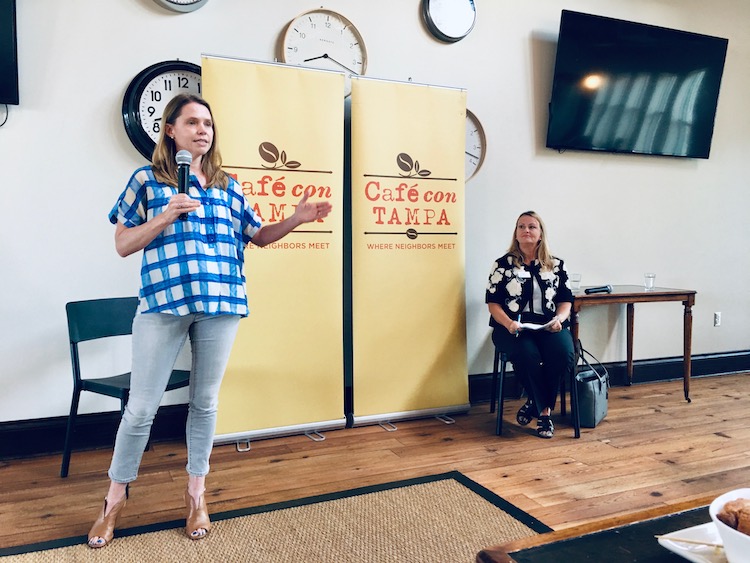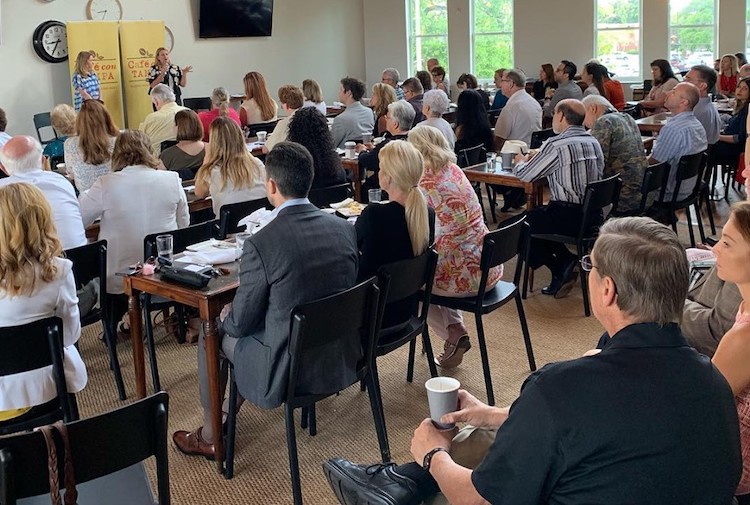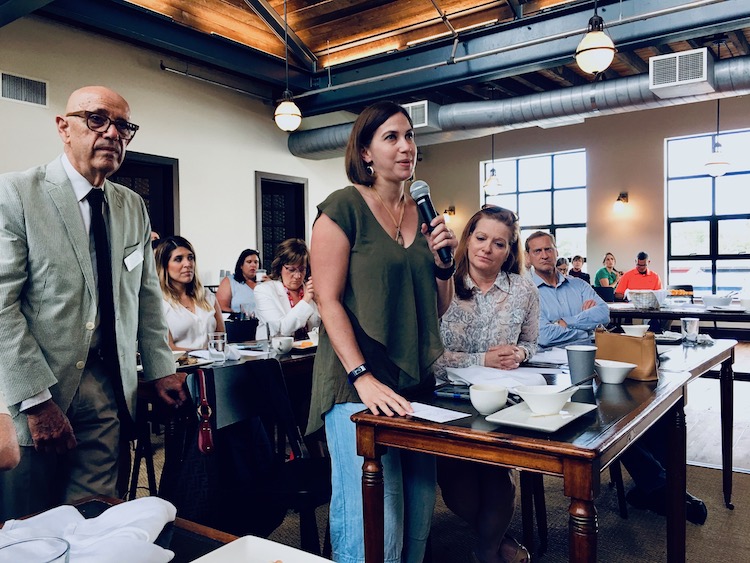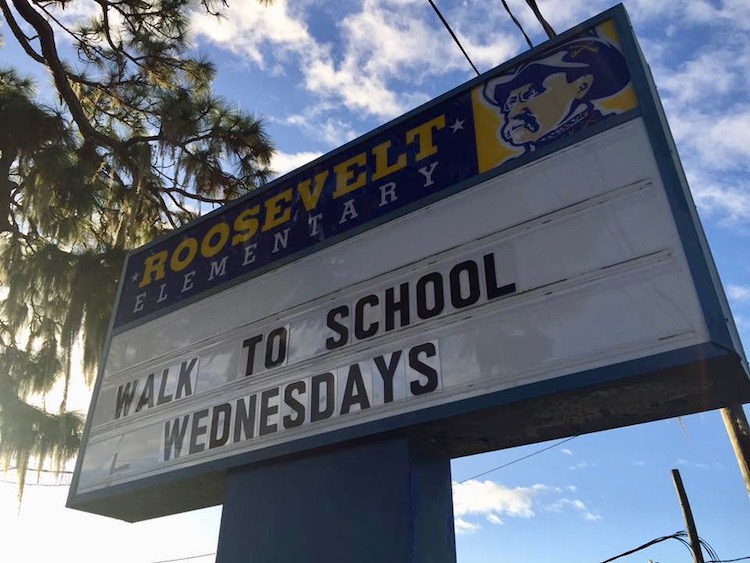Sidewalk Stompers take strides for pedestrian safety
A group of parents advocates on behalf of more and better sidewalks to increase safety for pedestrians, especially schoolchildren, in Tampa and Hillsborough County. Learn more.
Step by step, a group of parent advocates — the Sidewalk Stompers — are setting down markers for a campaign in support of more sidewalks, and more safety on the city of Tampa’s streets for pedestrians and bicyclists.
The core mission is to encourage students to walk or bicycle to schools and to build up communities. The group partners with school staff on a “Walk to School Wednesday” program where students meet and form a “walking bus.” Rewards, including toys and games, are given to classrooms with the highest percentage participation.
There is an added benefit of outdoor exercise when obesity and juvenile diabetes are at epidemic levels nationwide. And, it helps reduce the volume of traffic on local roads.
“We want to get more kids walking to school,” says Emily Hinsdale, one of five founders of the Palma Ceia-based Sidewalk Stompers. But, she says, “You have to make sure it’s safe for them to do so.”
Hinsdale, the Sidewalk Stompers, the Hillsborough Metropolitan Planning Organization, the Florida Department of Transportation and the MPO’s School Transportation Working Group are part of a coalition that promotes safe walkability and connectivity in Hillsborough County and Tampa.
Recently, Hinsdale and Lisa Silva, a principal planner with the MPO, spoke at a Café con Tampa breakfast about the Sidewalk Stompers as well as the findings and recommendations from a 2018 school transportation safety study.
Projects evolving from the study could get a significant boost from a voter-approved All for Transportation one-penny sales tax that passed in November 2018. Funds available for new and repaired sidewalks could jump from about $600,000 a year to as much as $6 million a year.
The tax currently is under legal challenge from Hillsborough County Commissioner Stacy White. Taxes collected can’t be spent while the lawsuit is pending.
Top priority: Sidewalks within 2 miles of schools
The school transportation study looked at 10 schools including Chamberlain High School, Sulphur Springs Elementary School, and Plant High School.
Data evaluated roadways within a two-mile radius and considered road and driveway design, visibility and lighting, signage and pavement markings, and a sidewalk inventory.
Silva supports the complete streets concept, where roads are designed to accommodate multi-modal travel including transit, motorized vehicles, walking, and biking.
“I believe our streets should be built for all users,” she says.
For instance, the need for sidewalks to aid disabled and elderly residents is critical, Silva adds. “It’s not easy for them to traverse a road without sidewalks.”
She is encouraged by the partnerships that are coming together on these critical issues. “There’s a big need to coordinate,” Silva says.
One of the goals to aid student walkers is creating a map of preferred routes to schools identifying routes that Silva says would be “stellar” but also noting routes that are deficient.
Problem roadways along school routes are being prioritized to find projects, both short-term and long-range, that can make them safer, she says.
“As we looked at each school, we started to see the problems and challenges,” Hinsdale says. “If you’re in your car, you’re separated from the community. If you’re out walking or biking, you’re out in the community. Strengthening the community requires face-to-face activities.”
The model for more school sidewalks and connectivity should be extended to commercial zones, and to parks and libraries, Hinsdale says.
“We need to find a way to get residents to walk to small businesses in their neighborhood,” she says. “The next at-risk group would be seniors. Having a safe path to be able to exercise and be in the community is very important.”
The idea for the Sidewalk Stompers rambled up more than two years ago as a small group of parents met daily to walk their children to Roosevelt Elementary School in a neighborhood with few sidewalks.
Hinsdale and her two daughters, now ages 10 and 13, were among the walkers.
“We have all enjoyed walking our children to school and thought if we enjoyed it, we’d like more people walking with us,” says Hinsdale. “We were looking for a way to promote this idea.”
They approached school staff at Roosevelt and found ready acceptance for starting the Wednesday walking program.
Initially, nearly 90 students showed up, but Hinsdale said the number quickly doubled.
The Sidewalk Stompers also recruited more schools into the program. This year five schools participated, with two more ready to start in fall.
Safety first: Moving walkers onto sidewalks
In West Tampa, Melissa Martin, president of the MacFarlane Neighborhood Association, quickly saw the benefits of the Sidewalk Stompers in a neighborhood with too many “sidewalks to nowhere.”
“We advocate quite a bit for sidewalks and getting rid of ditches in our neighborhood,” says Martin. “We were feeling kind of desperate. Our kids are walking in the middle of the street. Parents walk in the middle of the street. Or nobody was walking.”
Martin contacted the Sidewalk Stompers and soon Tampa Bay Boulevard Elementary School became the first school in the neighborhood to organize student walkers.
In a neighborhood with four elementary schools, three public and one private, Martin says there is an urgency to addressing the lack of sidewalks and ensuring the safety of students and neighbors who want to walk and ride bikes.
She likes the personal approach.
“Instead of telling people to walk, we’re doing it ourselves,” says Martin.
The walks were eye-opening.
It wasn’t just a lack of sidewalks, she says. In some instances, layers of grass and weeds gobbled up sidewalks installed years ago.
MacDill Avenue has some of those disappearing sidewalks. A section of Pine Street near the ballfields off MacDill is built to aid disabled residents, but Martin says, “The sidewalk is six to 12 inches wide because of growth” of grass and weeds covering the sidewalk.
Hinsdale is advocating for a review of the City of Tampa’s sidewalk ordinance with a focus on closing loopholes that block new sidewalk construction.
In some instances, property owners can opt out of installing new sidewalks, leaving neighborhoods with pieces of sidewalks and no connectivity, she says.
“I think we have to start not having it be, ‘not in my backyard’,” says Hinsdale.
Currently, new construction in residential and commercial areas may require sidewalk installation. But, if city officials decide sidewalks aren’t “practical,” according to city code, waivers can be granted, and a fee in lieu of the sidewalk paid into a sidewalk trust fund.
Hinsdale recently approached several new city councilmen on the matter, and, also spoke with the then-mayoral candidate – now Tampa Mayor Jane Castor.
She is hopeful there will be some traction favoring a sidewalk review.
There could be potholes ahead.
Some residents don’t look favorably on sidewalks. Instead, they see sidewalks and connectivity as an invitation for increased foot-traffic and thus access to neighborhoods that could lead to more crimes being committed.
The costs of sidewalks also will be an issue.
Sidewalks are a factor in the profits of new development and construction, says David Ferrill, a building contractor and owner of Ferrill Construction. He offered a likely scenario at Café con Tampa.
A $600,000 home built in South Tampa could require nearly $20,000 in impact fees and $3,000 for sidewalks. Probably not a problem, he suggested. But another home built at $350,000 and the same impact and sidewalk fees becomes problematic, he says.
It affects how affordable a home’s sales price is, and he says, “You’re at the point where the straw is breaking the camel’s back.”
Hinsdale says homes are more attractive for sale when there are sidewalks and landscaping.
“I think this is just something we’re going to have to cope with,” she says. “It’s something we have to buy into.”


















